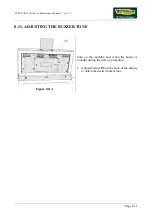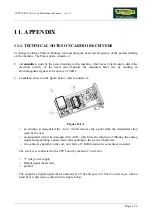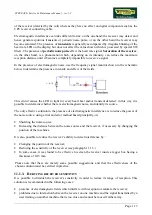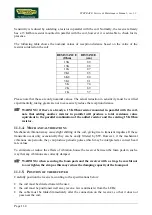
STEPRACE: Service & Maintenance Manual - rev. 1.2
Page 11.3
of the receiver (detected by the coil) whereas they have no effect on digital components such as the
CPU receiver connecting cable.
Electromagnetic interference can take different forms: on the one hand, the receiver may detect and
hence generate spurious transients or periodic noise pulse, or on the other hand the receiver may
become saturated. The presence of
transients
is generally accompanied by irregular blinking of the
heart rate LED on the display, but does not affect the value shown which is processed by special SW
filters. The presence of
periodic noise pulse
effect the heart rate signal.
Saturation of the receiver
,
on the other hand, is a phenomenon which, depending on its intensity, can reduce the maximum
reception distance until it becomes completely impossible to receive a signal.
In the presence of electromagnetic noise, use the frequency signal monitor shown in the schematic
below to determine the presence, intensity and effect of the fields.
This circuit causes the LED to light for every heart beat and/or transient detected: in this way it is
possible to determine whether there is electromagnetic noise, and identify its source.
The only effective solution in the presence of electromagnetic interference is to reduce the power of
the noise source, using a trial and error method based principally on:
•
Shielding the noise source.
•
Increasing the distance between the noise source and the receiver, if necessary by changing the
position of the machines.
It is also possible to reduce the receiver’s ability to detect interference by:
•
Changing the position of the receiver;
•
Reducing the sensitivity of the receiver (see paragraph 11.1.3. )
•
In some cases, it was found to be effective to screen the receiver inside a tagger box having a
thickness of 0.15 mm.
Please note that these are merely some possible suggestions, and that the effectiveness of the
chosen solution must be verified in practice.
11.1.3. R
EDUCING RECEIVER SENSITIVITY
It is possible to diminish the receiver’s sensitivity in order to reduce its range of reception. This
solution is recommended in the following cases:
•
presence of electromagnetic fields which interfere with reception or saturate the receiver;
•
problems due to interaction between the receiver on one machine and the signal transmitted by a
user training on another machine that is too close and cannot be moved farther away.
Summary of Contents for Steprace
Page 1: ...SERVICE MAINTENANCE MANUAL REV 1 2...
Page 2: ......
Page 4: ......
Page 8: ...STEPRACE Service Maintenance Manual rev 1 2 Page iv Page intentionally left blank...
Page 16: ...STEPRACE Service Maintenance Manual rev 1 2 Page 2 6 Page intentionally left blank...
Page 46: ...STEPRACE Service Maintenance Manual rev 1 2 Page 6 20 Page intentionally left blank...
Page 96: ...STEPRACE Service Maintenance Manual rev 1 2 Page 8 12 Page intentionally left blank...
Page 104: ...STEPRACE Service Maintenance Manual rev 1 2 Page 10 6 Page intentionally left blank...
Page 113: ......








































